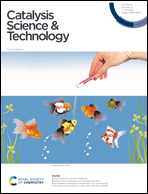The migration of Zn species on Zn/ZSM-5 catalyst during the process of ethylene aromatization
Abstract
Zn-Modified ZSM-5 zeolites are widely used in the ethylene aromatization reaction, but they suffer from rapid deactivation owing to the leaching of active zinc species. In this work, the structure, composition, and evolution manner of Zn species in different reaction stages of ethylene aromatization were investigated by XAS, TEM, XRD, ICP, and XPS. The results show that in the initial stage of the reaction, cationic zinc originated from the interaction between ZnO clusters and protons in ZSM-5 zeolite is the main component and dominant active site. With the progress of the reaction, the reciprocal transformation among zinc cations, the ZnO cluster inside the channel, and ZnO crystals outside the surface of zeolite, occurred with the formation of metallic Zn species that are responsible for not only the transformation but also the migration of Zn species. The amount of ZnOH+ species in the exchange position increased in the initial stage, which promoted the generation of aromatics, and then decreased owing to the weakening of the interaction between Zn species and the zeolite framework, forming ZnO species inside and outside the channel. In the deactivation stage, ZnO particles became the main components, accompanied by the loss of zinc species by metallic sublimation, which led to the decline of the catalytic performance of Zn/ZSM-5.



 Please wait while we load your content...
Please wait while we load your content...